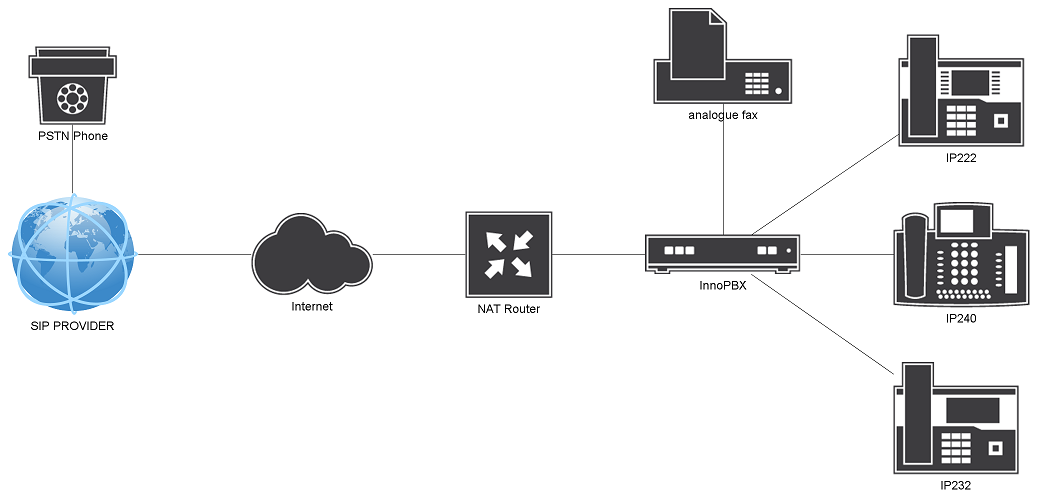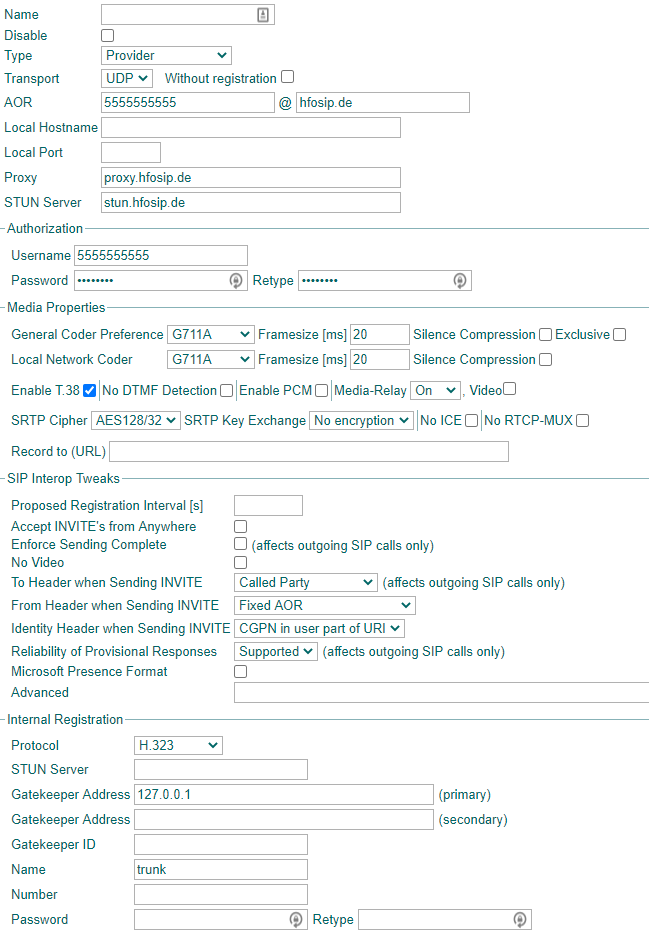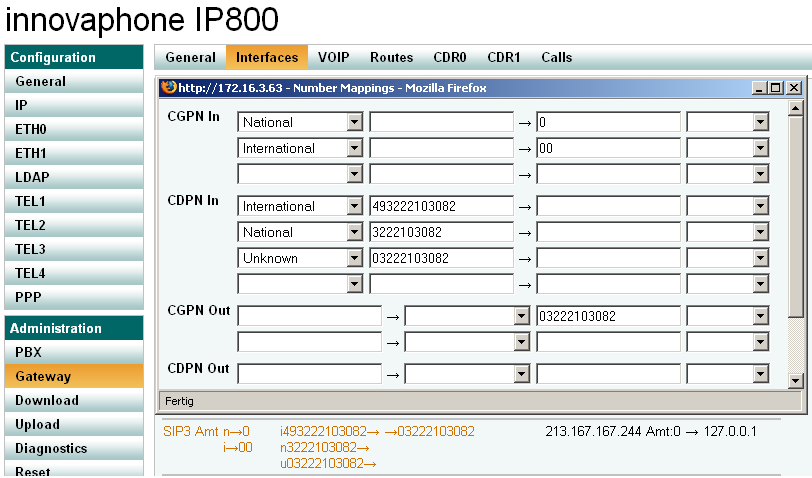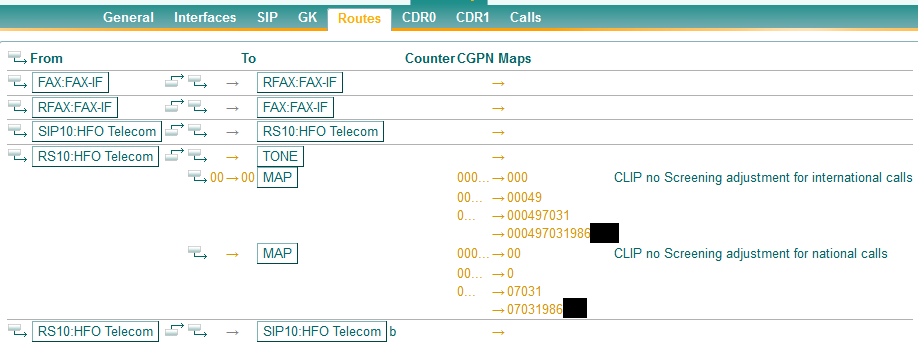Howto:HFO NGN Connect - HFO - SIP Provider: Difference between revisions
m (→Summary) |
|||
| (32 intermediate revisions by one other user not shown) | |||
| Line 1: | Line 1: | ||
'''Innovaphone Compatibility Test Report''' | '''Innovaphone Compatibility Test Report''' | ||
== Summary == | == Summary == | ||
| Line 9: | Line 7: | ||
The provider supports all required innovaphone features and is therefore qualified as [[Howto:What_is_a_%22recommended_product%22%3F#SIP_Provider|recommended SIP Provider]]. | The provider supports all required innovaphone features and is therefore qualified as [[Howto:What_is_a_%22recommended_product%22%3F#SIP_Provider|recommended SIP Provider]]. | ||
Only if the Mobility-feature or WebRTC is desired by the customer, you must enable Media-Relay on the SIP-Trunk. Opposed to a SIP trunk not needing Media-Relay, the transport of all RTP packets by the gateway will result in a higher CPU load for a call. As a result, the amount of concurrent calls is considerably lower compared to a SIP-Provider that doesn't require Media-Relay. | |||
The provider doesn't support the G.729 coder, this might be an issue in locations with low-bandwidth Internet connection. | |||
The PBX is connected to the provider through the public Internet, the tested product "HFO NGN Connect" comes without a dedicated Internet Access Device. | |||
According to the provider the amount of concurrent calls is limited when ordering the trunk, currently max. 220 concurrent calls are possible. | |||
The provider offers an additional SIP-trunk product called [http://www.hfo-telecom.de/produkte/geschaeftskunden/hfo-ngn-business HFO NGN Business]. This product comes with a dedicated Internet Access, used only for telephony. According to HFO, it uses the same SIP server as the tested product "HFO NGN Connect". As a result, the configuration on innovaphone side should be equal. For more details on the product "HFO NGN Business", please contact the provider directly. | |||
NAT - Detection doesn't work for all private networks, see [[Howto:HFO_NGN_Connect_-_HFO_-_SIP_Provider#Known_Problems | Known Problems]] for more information. | |||
That being said, the provider has achieved 92% of all possible test points. For more information on the test rating, please refer to [[Howto:SIP_Interop_Test_Description#|Test Description]] | |||
* Features: | * Features: | ||
** Direct Dial In | ** Direct Dial In | ||
** Fax over IP (T.38) | |||
** DTMF | ** DTMF | ||
** Clip No Screening | |||
* Supported Codecs by the provider | * Supported Codecs by the provider | ||
** G711 | ** G711 | ||
** | ** G722 | ||
** T.38 UDP | |||
== Current test state == | == Current test state == | ||
{{Template:Compat Status " | |||
<!--{{Template:Compat Status "planned"}} --> | |||
<!-- {{Template:Compat Status "in progress"}} --> | <!-- {{Template:Compat Status "in progress"}} --> | ||
<!--{{Template: | <!-- {{Template:Compat_Status_"referral_prod."|certificate=Tpl_sip.business_Toplink_SIP_Provider_-_product-cert.pdf}} --> | ||
<!-- {{Template:Compat_Status_"engineered_prod."|certificate=Tpl_sip.business_Toplink_SIP_Provider_-_product-cert.pdf}} --> | |||
{{Template:Compat_Status_"rec._prod."|certificate=HFO_NGN_Connect_HFO_SIP_Provider_-_product-cert.pdf}} | |||
<!-- {{Template:Compat Status "tested"(sip provider)}} --> | |||
<!-- {{Template:Compat Status "rejected"}} --> | <!-- {{Template:Compat Status "rejected"}} --> | ||
<!-- {{Template:Compat_Status_"referral_prod."-no-certificate}} --> | |||
Testing of this product has been finalized June 23th, 2015. | |||
Testing | == Testing Environment == | ||
[[Image:SIPProviderTestTopology1.PNG]] | |||
This scenario describes a setup where the PBX and phones are in a private network. | |||
* the SIP trunk is configured without Media Relay and without exclusive coder. Media-Relay must be only activated if ''Mobility'' is used. | |||
== Test Results == | == Test Results == | ||
For more information on the test procedure, please read the following wiki article: [[Howto:SIP_Interop_Test_Description|SIP Interop Test Description]]. Bold lines in the test results indicate a KO-criteria. | |||
=== Basic Call === | === Basic Call === | ||
{| border="1" | {| border="1" | ||
!Tested feature | !Tested feature | ||
!Result | !Result | ||
|---- | |||
|SIP over TLS(SIPS) | |||
|Nok | |||
|---- | |||
|SIP over TCP | |||
|Nok | |||
|---- | |---- | ||
| | |SRTP | ||
| | |Nok | ||
|---- | |---- | ||
|call using | |'''call using g711a''' | ||
| | |'''Ok''' | ||
|---- | |---- | ||
|call using | |'''call using g711u''' | ||
| | |'''Ok''' | ||
|---- | |---- | ||
|call using g729 | |call using g729 | ||
| | |Nok | ||
|---- | |||
|call using g722 | |||
|Ok | |||
|---- | |---- | ||
|Overlapped sending | |Overlapped sending | ||
| | |Nok | ||
|---- | |---- | ||
|early media channel | |'''early media channel''' | ||
| | |'''Ok''' | ||
|---- | |---- | ||
|Fax using T.38 | |Fax using T.38 | ||
| | |Ok | ||
|---- | |||
|T.38 Transcoding by the provider | |||
|Ok | |||
|---- | |||
|Reverse Media Negotiation | |||
|Ok | |||
|---- | |||
|CGPN can be suppressed | |||
|Ok | |||
|---- | |||
|CLIP no screening | |||
|Ok | |||
|---- | |||
|'''Long time call possible(>30 min)''' | |||
|'''Ok''' | |||
|---- | |||
|'''External Transfer''' | |||
|'''Ok''' | |||
|---- | |||
|NAT Detection | |||
|Ok* | |||
|---- | |||
|Redundancy | |||
|Ok | |||
|---- | |---- | ||
|Voice Quality OK? | |'''Voice Quality OK?''' | ||
| | |'''Ok''' | ||
|} | |} | ||
* NAT - Detection doesn't work for all private networks, see section [[Howto:HFO_NGN_Connect_-_HFO_-_SIP_Provider#Known_Problems | Known Problems]] for more information. | |||
=== Direct Dial In === | === Direct Dial In === | ||
{| border="1" | {| border="1" | ||
!Tested feature | !Tested feature | ||
!Result | !Result | ||
|---- | |---- | ||
|Inbound(Provider -> Innovaphone) | |'''Inbound(Provider -> Innovaphone)''' | ||
| | |'''Ok''' | ||
|---- | |---- | ||
|Outbound(Innovaphone -> Provider) | |'''Outbound(Innovaphone -> Provider)''' | ||
| | |'''Ok''' | ||
|---- | |||
|'''Loop In call(Innovaphone -> Provider -> Innovaphone)''' | |||
|'''Ok''' | |||
|} | |} | ||
=== DTMF === | === DTMF === | ||
{| border="1" | {| border="1" | ||
!Tested feature | !Tested feature | ||
!Result | !Result | ||
|---- | |---- | ||
|DTMF tones sent correctly | |'''DTMF tones sent correctly via RTP-events(RFC 2833)''' | ||
| | |'''Ok''' | ||
|---- | |---- | ||
|DTMF tones | |DTMF tones sent correctly via SIP-Info | ||
| | |Nok | ||
|---- | |---- | ||
|DTMF tones | |'''DTMF tones received correctly via RTP-events(RFC 2833)''' | ||
|'''Ok''' | |||
| | |||
|} | |} | ||
=== Hold/Retrieve === | === Hold/Retrieve === | ||
{| border="1" | |||
!Tested feature | |||
!Result | |||
|---- | |||
|'''Call can be put on hold''' | |||
|'''Ok''' | |||
|---- | |||
|Held end hears music on hold / announcement from PBX | |||
|Ok | |||
|} | |||
=== Transfer with consultation === | |||
{| border="1" | |||
!Tested feature | |||
!Result | |||
|---- | |||
|'''Call can be transferred''' | |||
|'''Ok''' | |||
|---- | |||
|Held end hears music on hold | |||
|Ok | |||
|} | |||
The following tests are made to test if call transfer is working. | |||
{| border="1" | {| border="1" | ||
!Tested feature | !Tested feature | ||
! | !Voice Ok? | ||
!MoH Ok? | |||
|---- | |---- | ||
| | |inno1 calls inno2. inno2 transfers to PSTN-phone. | ||
| | |Ok | ||
|Ok | |||
|---- | |---- | ||
| | |inno1 calls PSTN-phone. inno1 transfers to inno2. | ||
| | |Ok | ||
|Ok | |||
|---- | |||
|inno1 calls PSTN-phone. PSTN-phone transfers to inno2. | |||
|Ok | |||
|Ok | |||
|---- | |||
|PSTN-phone calls inno1. inno1 transfers to inno2. | |||
|Ok | |||
|Ok | |||
|---- | |---- | ||
| | |PSTN-phone calls inno1. PSTN-phone transfers to inno2. | ||
| | |Ok | ||
|Ok | |||
|---- | |---- | ||
| | |PSTN-phone calls inno1. inno1 transfers to other PSTN-phone-2. | ||
| | |Ok | ||
|Ok | |||
|} | |} | ||
=== Transfer with consultation (alerting only) === | |||
=== Transfer with consultation === | |||
{| border="1" | {| border="1" | ||
!Tested feature | !Tested feature | ||
!Result | !Result | ||
|---- | |---- | ||
|Call can be | |'''Call can be transferred''' | ||
| | |'''Ok''' | ||
|---- | |---- | ||
|Held end hears music on hold | |Held end hears music on hold or dialling tone | ||
| | |Ok | ||
|---- | |---- | ||
|Call returns to transferring device if the third | |'''Call returns to transferring device if the third''' | ||
Endpoint is not available | '''Endpoint is not available''' | ||
| | |'''Ok''' | ||
|} | |} | ||
The following tests are made to test if call transfer is working. | |||
{| border="1" | {| border="1" | ||
!Tested feature | !Tested feature | ||
! | !Voice Ok? | ||
!MoH Ok? | |||
|---- | |||
|inno1 calls inno2. inno2 transfers to PSTN-phone. | |||
|Ok | |||
|Ok | |||
|---- | |||
|inno1 calls PSTN-phone. inno1 transfers to inno2. | |||
|Ok | |||
|Ok | |||
|---- | |---- | ||
| | |inno1 calls PSTN-phone. PSTN-phone transfers to inno2. | ||
| | |Ok | ||
|Ok | |||
|---- | |---- | ||
| | |PSTN-phone calls inno1. inno1 transfers to inno2. | ||
| | |Ok | ||
|Ok | |||
|---- | |---- | ||
| | |PSTN-phone calls inno1. PSTN-phone transfers to inno2. | ||
|Ok | |||
| | |Ok | ||
|---- | |||
|PSTN-phone calls inno1. inno1 transfers to other PSTN-phone-2. | |||
|Ok | |||
|Ok | |||
|} | |} | ||
=== Blind Transfer === | === Blind Transfer === | ||
{| border="1" | {| border="1" | ||
!Tested feature | !Tested feature | ||
!Result | !Result | ||
|---- | |---- | ||
|Call can be | |Call can be transferred | ||
| | |Ok | ||
|---- | |---- | ||
|Held end hears | |Held end hears dialling tone | ||
| | |Ok | ||
|} | |} | ||
The following tests are made to test if call transfer is working. | |||
{| border="1" | {| border="1" | ||
!Tested feature | !Tested feature | ||
! | !Voice Ok? | ||
|---- | |||
|inno1 calls inno2. inno2 transfers to PSTN-phone. | |||
|Ok | |||
|---- | |---- | ||
| | |inno1 calls PSTN-phone. inno1 transfers to inno2. | ||
| | |Ok | ||
|---- | |---- | ||
| | |inno1 calls PSTN-phone. PSTN-phone transfers to inno2. | ||
| | |Ok | ||
|---- | |---- | ||
| | |PSTN-phone calls inno1. inno1 transfers to inno2. | ||
| | |Ok | ||
|---- | |||
|PSTN-phone calls inno1. PSTN-phone transfers to inno2. | |||
|Ok | |||
|---- | |||
|PSTN-phone calls inno1. inno1 transfers to other PSTN-phone-2. | |||
|Ok | |||
|} | |} | ||
=== | === CFU / CFB Transfer === | ||
{| border="1" | |||
!Tested feature | |||
!Result | |||
|---- | |||
|'''Call can be forwarded''' | |||
|Ok | |||
|---- | |||
|'''Held end hears dialling tone''' | |||
|Ok | |||
|} | |||
=== CFNR / Blind Transfer (alerting only)=== | |||
{| border="1" | {| border="1" | ||
!Tested feature | !Tested feature | ||
!Result | !Result | ||
|---- | |---- | ||
| | |'''Call can be transferred or forwarded''' | ||
| | |'''Ok''' | ||
|---- | |---- | ||
| | |'''Held end hears dialling tone''' | ||
| | |'''Ok''' | ||
|} | |} | ||
The following tests are made to test if call transfer is working. | |||
= | {| border="1" | ||
!Tested feature | |||
!Voice Ok? | |||
|---- | |||
|inno1 calls inno2. inno2 transfers to PSTN-phone. | |||
|Ok | |||
|---- | |||
|inno1 calls PSTN-phone. PSTN-phone transfers to inno2. | |||
|Ok | |||
|---- | |||
|PSTN-phone calls inno1. inno1 transfers to inno2. | |||
|Ok | |||
|---- | |||
|PSTN-phone calls inno1. inno1 transfers to other PSTN-phone-2. | |||
|Ok | |||
|} | |||
=== Broadcast Group & Waiting Queue === | |||
{| border="1" | |||
!Tested feature | |||
!Result | |||
|---- | |||
|'''Caller can make a call to a Broadcast Group''' | |||
|'''Ok''' | |||
|---- | |||
|'''Caller can make a call to a Waiting Queue''' | |||
|'''Ok''' | |||
|---- | |||
|'''Announcement if nobody picks up the call''' | |||
|'''Ok''' | |||
|} | |||
== Configuration == | |||
===Firmware version=== | |||
All innovaphone devices use V11r2 SR1 as firmware. | |||
=== SIP - Trunk === | === SIP - Trunk === | ||
First of all the SIP Trunk must be configured. Here an example of our HFO - Trunk. If the Mobility-feature is desired by the customer, you must enable ''Media-Relay'' on the SIP-Trunk. | |||
[[Image:HFO SIP.PNG]] | |||
=== Number Mapping === | |||
The provider uses a CDPN in national format for incoming call. Therefore the SIP-interface maps must be configured accordingly. | |||
[[Image:HFO SIP Compatibility Test | [[Image:HFO SIP Compatibility Test 2.PNG]] | ||
=== Route Settings === | === Route Settings === | ||
Because HFO, as most SIP - Providers too, doesn't support overlap sending, you must enable the blockwise sending of the phone number. You can do this by enabling ''Force enblock'' in the automatically generated Routes. | Because HFO, as most SIP - Providers too, doesn't support overlap sending, you must enable the blockwise sending of the phone number. You can do this by enabling ''Force enblock'' in the automatically generated Routes. | ||
[[Image:HFO SIP Compatibility Test 3.PNG]] | [[Image:HFO SIP Compatibility Test 3.PNG]] | ||
If there is a problem with the number format, make sure to read also [[Howto:Create_ClipNoScreening_Maps_for_SIP_Interfaces]] | |||
[[ | |||
=== Fax === | |||
The provider supports T.38, make sure to enable it on the SIP-interface and also on all analogue - interfaces used for fax-machines . | |||
== Known Problems == | |||
HFO doesn't support NAT Traversal for clients using private addresses in 172.16.0.0/24 to 172.31.0.0/24 networks. In case that this private networks are used, STUN must be used at the RTP endpoints. In order for NAT-Traversal using STUN to work, the [[Reference11r1:Concept_Using_PBX_services_from_public_internet#Detecting_the_NAT_style |NAT-Router must support full-cone or restricted NAT]]. | |||
[[Category:Compat|{{PAGENAME}}]] | [[Category:Compat|{{PAGENAME}}]] | ||
Latest revision as of 14:40, 30 September 2020
Innovaphone Compatibility Test Report
Summary
SIP Provider: HFO
The provider supports all required innovaphone features and is therefore qualified as recommended SIP Provider.
Only if the Mobility-feature or WebRTC is desired by the customer, you must enable Media-Relay on the SIP-Trunk. Opposed to a SIP trunk not needing Media-Relay, the transport of all RTP packets by the gateway will result in a higher CPU load for a call. As a result, the amount of concurrent calls is considerably lower compared to a SIP-Provider that doesn't require Media-Relay.
The provider doesn't support the G.729 coder, this might be an issue in locations with low-bandwidth Internet connection.
The PBX is connected to the provider through the public Internet, the tested product "HFO NGN Connect" comes without a dedicated Internet Access Device. According to the provider the amount of concurrent calls is limited when ordering the trunk, currently max. 220 concurrent calls are possible.
The provider offers an additional SIP-trunk product called HFO NGN Business. This product comes with a dedicated Internet Access, used only for telephony. According to HFO, it uses the same SIP server as the tested product "HFO NGN Connect". As a result, the configuration on innovaphone side should be equal. For more details on the product "HFO NGN Business", please contact the provider directly.
NAT - Detection doesn't work for all private networks, see Known Problems for more information.
That being said, the provider has achieved 92% of all possible test points. For more information on the test rating, please refer to Test Description
- Features:
- Direct Dial In
- Fax over IP (T.38)
- DTMF
- Clip No Screening
- Supported Codecs by the provider
- G711
- G722
- T.38 UDP
Current test state

Testing of this product has been finalized June 23th, 2015.
Testing Environment
This scenario describes a setup where the PBX and phones are in a private network.
- the SIP trunk is configured without Media Relay and without exclusive coder. Media-Relay must be only activated if Mobility is used.
Test Results
For more information on the test procedure, please read the following wiki article: SIP Interop Test Description. Bold lines in the test results indicate a KO-criteria.
Basic Call
| Tested feature | Result |
|---|---|
| SIP over TLS(SIPS) | Nok |
| SIP over TCP | Nok |
| SRTP | Nok |
| call using g711a | Ok |
| call using g711u | Ok |
| call using g729 | Nok |
| call using g722 | Ok |
| Overlapped sending | Nok |
| early media channel | Ok |
| Fax using T.38 | Ok |
| T.38 Transcoding by the provider | Ok |
| Reverse Media Negotiation | Ok |
| CGPN can be suppressed | Ok |
| CLIP no screening | Ok |
| Long time call possible(>30 min) | Ok |
| External Transfer | Ok |
| NAT Detection | Ok* |
| Redundancy | Ok |
| Voice Quality OK? | Ok |
* NAT - Detection doesn't work for all private networks, see section Known Problems for more information.
Direct Dial In
| Tested feature | Result |
|---|---|
| Inbound(Provider -> Innovaphone) | Ok |
| Outbound(Innovaphone -> Provider) | Ok |
| Loop In call(Innovaphone -> Provider -> Innovaphone) | Ok |
DTMF
| Tested feature | Result |
|---|---|
| DTMF tones sent correctly via RTP-events(RFC 2833) | Ok |
| DTMF tones sent correctly via SIP-Info | Nok |
| DTMF tones received correctly via RTP-events(RFC 2833) | Ok |
Hold/Retrieve
| Tested feature | Result |
|---|---|
| Call can be put on hold | Ok |
| Held end hears music on hold / announcement from PBX | Ok |
Transfer with consultation
| Tested feature | Result |
|---|---|
| Call can be transferred | Ok |
| Held end hears music on hold | Ok |
The following tests are made to test if call transfer is working.
| Tested feature | Voice Ok? | MoH Ok? |
|---|---|---|
| inno1 calls inno2. inno2 transfers to PSTN-phone. | Ok | Ok |
| inno1 calls PSTN-phone. inno1 transfers to inno2. | Ok | Ok |
| inno1 calls PSTN-phone. PSTN-phone transfers to inno2. | Ok | Ok |
| PSTN-phone calls inno1. inno1 transfers to inno2. | Ok | Ok |
| PSTN-phone calls inno1. PSTN-phone transfers to inno2. | Ok | Ok |
| PSTN-phone calls inno1. inno1 transfers to other PSTN-phone-2. | Ok | Ok |
Transfer with consultation (alerting only)
| Tested feature | Result |
|---|---|
| Call can be transferred | Ok |
| Held end hears music on hold or dialling tone | Ok |
| Call returns to transferring device if the third
Endpoint is not available |
Ok |
The following tests are made to test if call transfer is working.
| Tested feature | Voice Ok? | MoH Ok? |
|---|---|---|
| inno1 calls inno2. inno2 transfers to PSTN-phone. | Ok | Ok |
| inno1 calls PSTN-phone. inno1 transfers to inno2. | Ok | Ok |
| inno1 calls PSTN-phone. PSTN-phone transfers to inno2. | Ok | Ok |
| PSTN-phone calls inno1. inno1 transfers to inno2. | Ok | Ok |
| PSTN-phone calls inno1. PSTN-phone transfers to inno2. | Ok | Ok |
| PSTN-phone calls inno1. inno1 transfers to other PSTN-phone-2. | Ok | Ok |
Blind Transfer
| Tested feature | Result |
|---|---|
| Call can be transferred | Ok |
| Held end hears dialling tone | Ok |
The following tests are made to test if call transfer is working.
| Tested feature | Voice Ok? |
|---|---|
| inno1 calls inno2. inno2 transfers to PSTN-phone. | Ok |
| inno1 calls PSTN-phone. inno1 transfers to inno2. | Ok |
| inno1 calls PSTN-phone. PSTN-phone transfers to inno2. | Ok |
| PSTN-phone calls inno1. inno1 transfers to inno2. | Ok |
| PSTN-phone calls inno1. PSTN-phone transfers to inno2. | Ok |
| PSTN-phone calls inno1. inno1 transfers to other PSTN-phone-2. | Ok |
CFU / CFB Transfer
| Tested feature | Result |
|---|---|
| Call can be forwarded | Ok |
| Held end hears dialling tone | Ok |
CFNR / Blind Transfer (alerting only)
| Tested feature | Result |
|---|---|
| Call can be transferred or forwarded | Ok |
| Held end hears dialling tone | Ok |
The following tests are made to test if call transfer is working.
| Tested feature | Voice Ok? |
|---|---|
| inno1 calls inno2. inno2 transfers to PSTN-phone. | Ok |
| inno1 calls PSTN-phone. PSTN-phone transfers to inno2. | Ok |
| PSTN-phone calls inno1. inno1 transfers to inno2. | Ok |
| PSTN-phone calls inno1. inno1 transfers to other PSTN-phone-2. | Ok |
Broadcast Group & Waiting Queue
| Tested feature | Result |
|---|---|
| Caller can make a call to a Broadcast Group | Ok |
| Caller can make a call to a Waiting Queue | Ok |
| Announcement if nobody picks up the call | Ok |
Configuration
Firmware version
All innovaphone devices use V11r2 SR1 as firmware.
SIP - Trunk
First of all the SIP Trunk must be configured. Here an example of our HFO - Trunk. If the Mobility-feature is desired by the customer, you must enable Media-Relay on the SIP-Trunk.
Number Mapping
The provider uses a CDPN in national format for incoming call. Therefore the SIP-interface maps must be configured accordingly.
Route Settings
Because HFO, as most SIP - Providers too, doesn't support overlap sending, you must enable the blockwise sending of the phone number. You can do this by enabling Force enblock in the automatically generated Routes.
If there is a problem with the number format, make sure to read also Howto:Create_ClipNoScreening_Maps_for_SIP_Interfaces
Fax
The provider supports T.38, make sure to enable it on the SIP-interface and also on all analogue - interfaces used for fax-machines .
Known Problems
HFO doesn't support NAT Traversal for clients using private addresses in 172.16.0.0/24 to 172.31.0.0/24 networks. In case that this private networks are used, STUN must be used at the RTP endpoints. In order for NAT-Traversal using STUN to work, the NAT-Router must support full-cone or restricted NAT.



